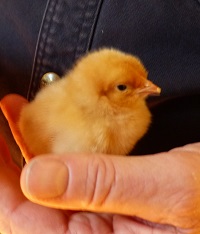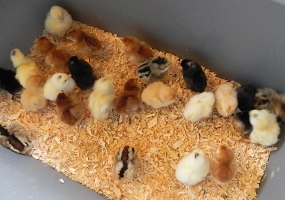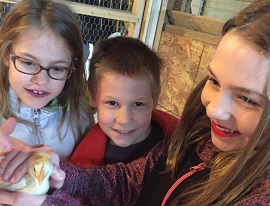by Marion Patterson | Sep 4, 2020 | Chickens
Well, you don’t. These powerful storms develop quickly from what seems like a “normal” thunderstorm. Even the weather service can be caught off guard as happened Monday, August 10, 2020, as a series of storms developed over Nebraska and swept East rapidly.
Gustavus Hinrichs, a Danish immigrant, and professor at the University of Iowa, recognized these storms differ from hurricanes because the winds move quickly in a straight line. Hence, derecho.
This link has satellite imagery of the formation of the derecho with Eastern Iowa being the epicenter. Over 20 counties have qualified for disaster aid.
Winding Pathways sustained damage especially the trees. And, we are working each day in the community to help recover. In the future, create.
For now, we invite readers to support local organizations in communities damaged by natural forces like fires, storms, and droughts.
 We are OK. The chickens were truly “free-ranging” for ten days before we got temporary fencing back up. They keep eating our food scraps, foraging for insects, and laying eggs so all is well.
We are OK. The chickens were truly “free-ranging” for ten days before we got temporary fencing back up. They keep eating our food scraps, foraging for insects, and laying eggs so all is well.
And, we will update as we can.
Go to our posts on preparedness and we will post updates of what we learned to add to preparedness. Remembering that different emergencies require different responses and different preparedness techniques.
Be well.
by Marion Patterson | May 9, 2019 | (Sub)Urban Homesteading, Bugs, Foraging, Garden/Yard, Nature, Uncategorized
A delightful swatch of color flitted by as we sat on our back deck on one of spring’s first warm sunny days. It was a red admiral butterfly that landed on a post just a few feet from us. It appeared to be enjoying the weather as much as we were.
We’ve since spotted many red admirals in the yard, probably because stinging nettles thrive on the north end of our property. It’s the favored plant for red admiral caterpillars, although they’ll also live on other types of nettles. That poses somewhat of a dilemma.
What is a Red Admiral Butterfly?

These colorful butterflies depend on early blooming plants like nettles.
Red Admirals are a common butterfly across much of the temperate globe. They’re found across Europe and Asia, North Africa, Hawaii, and much of North America, especially the eastern half of our continent. The larvae feed on stinging nettles, which may not be native. So, if red admirals need stinging nettles what did they eat before the plant was introduced to North America in the early days of European exploration? It’s not even certain that stinging nettles are exotic. They may have been here all along, or early butterflies may have fed on wood nettles.
We appreciate both the insect and plant here at Winding Pathways. Red admirals add color and movement to the yard, while nettles make delicious eating. It’s the first wild green we harvest each early spring.
Can You Eat Nettles?

Carefully pluck the top three leaves off.
Stinging nettles are ready to harvest early – about the time when chard, spinach, and lettuce are planted. When the nettles are just a few inches tall we pluck off the top three or four leaves. They are called stinging nettles because the plant has tiny hairlike stingers. Walk through a patch in summer wearing shorts and nettles cause instant pain. But it’s temporary and not dangerous. Another name for the plant is the “seven-minute itch.” The sting comes from histamines.
We gather young nettles without getting stung by carefully plucking just the top leaves between our thumb and forefinger and snapping them off. About 100 young nettle tops make two servings. We bring them into the kitchen, rinse them a couple of times, and steam them for just a minute or two. The sting disappears and resulting greens are delicious. Plus they pack a nutritious array of vitamins and are high in protein.
Nettle season is short. By the time the plants are eight or ten inches tall, the new leaves are getting tough. But by then we’re harvesting chard and spinach from the garden.
We’re happy to share our yard with both red admirals and nettles. Anyone with a partly shady yard with damp soil might want to start a nettle patch. Wear a pair of gloves and dig up a few and plant them in the yard. They aren’t fussy and will provide excellent table fare and a higher likelihood that the yard will be home to the colorful butterfly.
by Marion Patterson | Apr 25, 2019 | (Sub)Urban Homesteading, Children/Play, Garden/Yard, Garden/Yard, Nature
-

-
Kids take to the woods.
-

-
Starting off carefully.
-

-
Walking confidently.
Kid Adventure
Nature reduces stress. We saw it in action at Winding Pathways on an early April Sunday morning.
About 15 kids from the Faith Formation Group of Peoples Church Unitarian Universalist visited. Most were five to ten years old. After collecting eggs and scattering treats for the hens, we took them to Faulke’s Heritage Woods. It’s a 110-acre woodland protected from development by a conservation easement held by the Iowa Natural Heritage Foundation.
It wasn’t a guided walk. It was a kid adventure. As we distantly watched, the kids scampered into the oaks where they discovered a huge fallen tree spanning a ravine. A natural bridge. They couldn’t resist making the crossing and then raced from fallen log to fallen log, traversing each. Laughter entertained the many standing trees as the kids were enveloped in nature, inventing games and having fun. No constructed playground in a city park or schoolyard matches the wonder and fun of ponds, prairies, and tiny streams.
-

-
Careful calculations
-

-
Learning to navigate a log.
-

-
Exploring the log
Lots of research has been conducted on nature’s ability to relieve stress in both adults and children. Experts call time spent in beautiful places the nature pill and even 20 minutes spent walking in the woods reduces stress.
Everyone Benefits
Mary Carol Hunter recently completed a nature pill study and said, “Our study shows that for the greatest payoff, in terms of efficiently lowering levels of the stress hormone cortisol, you should spend 20 to 30 minutes sitting or walking in a place that provides you with a sense of nature.”
We’re lucky to have Faulke’s Woods adjacent to Winding Pathways, but most of our time outdoors is spent close to our home on our own property. Often, it’s simply sitting in the yard enjoying a cup of coffee as we watch chickadees flit around.
Hunter’s words, “sense of nature” are powerful. Although visits to national and state parks, wildlife refuges, and nature preserves are wonderful stress relievers, anyone’s yard or balcony can do the same. We created Winding Pathways several years ago to encourage people to enjoy their yard, even if that’s a tiny apartment balcony in a big city. Structuring the yard or balcony to create natural beauty attracts interesting wildlife while giving people easy and free access to the “nature pill.”
Go outside and have fun, just like the kids did in Faulke’s Woods.
by Marion Patterson | Mar 14, 2019 | (Sub)Urban Homesteading, Chickens, Garden/Yard
In the past few years, thousands of Americans have begun tending small flocks of chickens in their backyards. For most folks, it’s a new hobby, but we’ve been at it far longer. Rich began raising chickens in his suburban backyard when he was eight or nine years old – over 60 years ago. Marion’s family raised chickens at their New Hampshire home.
This spring many chicken newcomers will install a coop, raise chicks, and produce delicious food in their yards. It can be complicated, so this blog is designed to explain chicken husbandry in its very simplest form. Many books in most libraries and websites on chicken culture give detailed chicken care information and are outstanding resources. We recommend checking Hoover’s Hatchery. It offers a printed catalog, an online catalog, and website blogs. We also do a Facebook Live program each month for Hoover’s about different aspects of chicken care. Also see Scoop from the Coop for detailed information.
Chicks

Baby chicks can be purchased on line.
Baby chicks can be purchased online. Most hatcheries require a minimum order of 15 or 25 babies, usually more than most families want. Smaller quantities can be purchased at farm stores, such as Tractor Supply. Many cities have ordinances allowing chickens but usually limit the flock size to six or fewer birds. Check your local ordinance before buying.
Chicks come in dozens of different breeds, but we suggest choosing those that lay brown eggs. These breeds are fairly large bodied, calm birds. Our long-term favorites are New Englanders like the Rhode Island or New Hampshire Reds, or the Barred Plymouth Rock. Other great breeds are Wyandottes, Orpingtons, and Australorps. White egg breeds, like Leghorns, lay like crazy but are more nervous and noisier than brown eggers.
Often, it’s possible to buy a variety of breeds. Having a six hen flock composed of six different breeds is colorful and fun.
Housing

Chicks need to be warm until their insulating feather grow.
Baby chicks need to be warm until their insulating feathers grow. They are reared in a device called a brooder. A simple one can be made with items most people have around the house. See the blog on building a brooder on Hoover’s Hatchery Website for detail.
By the time the babies are six weeks, or so, old they need to move into permanent quarters, the chicken coop. The easiest way for a family to start is to buy a pre-made coop online or at a farm store. These range in size from tiny ones that will fit just a couple of hens to those that might fit up to a dozen. It’s a good idea to have an attached outside fenced in area, called a run, so the hens can enjoy fresh air and sunshine. Building a coop isn’t difficult and plans are printed in most basic chicken books or can be downloaded from websites.
Chicken houses need fluffy bedding, called litter, covering the floor. Pine chips work great. Bales of chips can be bought at farm stores. Every coop should have a nest for hens to lay their eggs in and a pole installed parallel to the floor for them to roost on. Yup, chickens sleep standing up.
The house should have windows that can be closed to prevent cold winter drafts but open to welcome fresh summer air. Cover windows with mosquito mesh and heavy wire to discourage both bugs and raccoons. Neighborhood raccoons would love a chicken dinner, so keep them out of the coop!
Food and Drink
Stores that sell baby chicks almost always sell feed. Babies need a high protein mash called Chick Starter from the time they hatch until they lay their first egg. Then switch to Layer feed. Simple inexpensive feeders are sold in farm stores. Chickens love drinking fresh water so invest in a water fount and keep it full. Hens enjoy a handful of corn every once in a while, as a treat. They also love table scraps. We give ours bits of rice, squash seeds and hulls, meat scraps and a few other things. As with all treats, we keep portions small.
The Nutshell

Raising chickens helps kids learn care and responsibility.
This is chicken husbandry in a nutshell. There’s lots more to it, so be sure to read websites and books on chicken care before buying your first batch of chicks. If you are lucky you can take a backyard chicken basic class at a nearby nature or garden center.
 We are OK. The chickens were truly “free-ranging” for ten days before we got temporary fencing back up. They keep eating our food scraps, foraging for insects, and laying eggs so all is well.
We are OK. The chickens were truly “free-ranging” for ten days before we got temporary fencing back up. They keep eating our food scraps, foraging for insects, and laying eggs so all is well.










